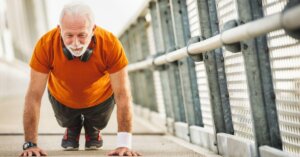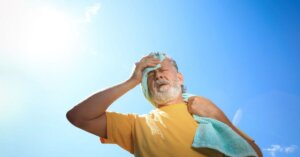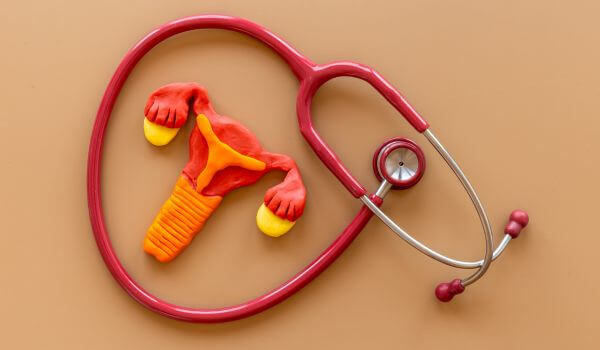As summer wanes and temperatures moderate, our focus naturally moves from the unprecedented extreme temperatures that have created dangerous weather in so many parts of the country. As healthy as it is to move forward, it is important to remember some lessons learned – especially regarding how high temperatures can affect heart health and even induce heart failure. The summer will return as it always does, and unless the lessons of these heat spells can be internalized, there will likely be another surge in (often fatal) cardiovascular events.
There are two main heart-health-related takeaways from the summer of 2023.

Lesson one: Extreme heat can induce heart failure even in healthy people. People now need to be aware of the signs of heart failure because early and proper treatment can make all the difference between a rapid recovery or permanent and even fatal outcomes.
Lesson two: People with pre-existing cardiovascular conditions can be hyper-sensitive to even moderate increases in ambient temperature. Not everyone may be aware of their latent conditions, and they should have been taking special precautions in case exposure to high temperatures tips them over the edge into full-blown heart failure.
What are the causes of heart failure from high temperatures?
Let’s start with the first lesson. For people who have never experienced any signs of heart failure, what are the dangers to heart health from high temperatures?
In hot weather, the body has to work hard to keep its core temperature at normal levels. Ordinary activity and the ongoing processes of metabolism all generate heat. A healthy body has automatic processes that should keep the core temperature at around 97 degrees Fahrenheit (38 degrees Celsius) by sweating and panting. In an optimal ambient temperature, sweating cools down the outer layer of skin, and warm blood pumped through it can return cooler to the core. Panting takes warm, moist air and expels it through the lungs, sucking in the dryer and cooler air from outside.
But what if the outside temperature is already higher than the optimum? In that case, radiating the body’s heat becomes less efficient. To adjust, the heart needs to push more warm blood into the outer skin layers where heat can be radiated, and the lungs must work harder to push out warm air. All of this puts extra strain on the heart, lungs and kidneys. It can become a vicious cycle because as the heart works harder, it requires more oxygen, so it has to push more blood through the lungs, which is more strain.
Suppose the outside temperature is higher than around 102F (40C), especially if the humidity is already high. In that case, the process starts to break down, and the genuine danger of heat stroke begins. Symptoms of heat stroke include:
- excessive sweating
- cold, clammy skin
- dizziness
- fainting
- muscle cramps
- heat rash
- edema in the ankles
- shallow and fast breathing
- nausea and vomiting.
If untreated, heat stroke can be fatal.
Five symptoms of cardiovascular disease
Recognizing symptoms in an environment with high temperatures can substantially affect long-term health for people who have never been diagnosed with cardiovascular disease.
Even before consulting with a healthcare provider, it’s worthwhile being able to pick up any signs that something is going wrong inside the heart. The #1 symptom of cardiovascular disease is angina. It’s essential to recognize the difference between angina and a heart attack. The main signs of angina are a pressing, squeezing, or crushing pain in the chest under the breastbone, which can spread to the back and both arms. The pain typically lasts for only ten to fifteen minutes and usually stops as long as the person rests. The main sign of a heart attack is chest tightness and pain in the left side of the chest radiating down the left arm. If this is the first time these symptoms are felt, it should be treated as an emergency, and help must be sought immediately.
Five other common signs of early cardiovascular diseases are:
- Numbness, pain, or weakness in legs or arms.
- Breathlessness.
- Palpitations, or a fast or uneven pulse.
- Feeling dizzy, lightheaded, or faint.
- Swollen limbs are a sign of poor blood supply to the extremities.
What are the types of cardiovascular disease?
As we said above, it’s vital for anyone subject to unusual and extreme heat for prolonged periods to be aware of any underlying cardiac problems because the extra stress from coping with the heat can suddenly trigger cardiac failure.
Cardiovascular disease (CVD) is a term used to describe a range of diseases of the heart or blood vessels. There are 4 types of cardiovascular disease.
- Coronary heart disease (CHD) occurs when the supply of oxygen-rich blood to the heart muscles is blocked or interrupted. This can be due to a steady build-up of plaque (atheroma) in the coronary arteries that can come from a poorly balanced diet with too much low-density cholesterol (LDL). The main symptom is angina, but when a coronary artery becomes blocked, it can cause a heart attack, which could be fatal.
- A stroke occurs when the blood supply to the brain is reduced. The brain relies on a steady supply of oxygen and nutrients from the blood flowing from the heart. Brain cells will die without oxygen, leading to brain damage and possibly death.
- Peripheral arterial disease (or peripheral vascular disease) happens if blood flow to the legs (sometimes the arms) is blocked. The main symptoms are pain in the thighs, hips, or calves when walking.
- Aortic aneurysm, where the wall of the aorta (the blood vessel that carries blood from the heart back to the rest of the body) is weakened and bulges outwards. It is usually experienced as chest, back, or abdomen pain.
Questions people ask
What is the most fatal cardiovascular disease?
Sudden cardiac death comes most often from cardiac arrest. According to the US Government’s Center for Disease Control and Prevention, it is the most significant cause of natural death in the US, resulting in around 325,000 adult deaths yearly and about 50% of all heart disease deaths.
Sudden cardiac death affects men twice as often as women, mostly in adults aged mid-30s to mid-40s. It is unusual in children.
When the body suffers a sudden cardiac arrest, vital organs no longer receive oxygen and cannot survive for more than a few minutes at most. It is fatal without immediate resuscitation to help get oxygen-rich blood flowing into the brain and other organs.
How do you know if you have heart problems?
Often, there are no immediate signs of heart failure until some extra stress is placed on the heart like the past summer’s extreme heat has been doing.
In the background, if the heart can’t supply enough oxygen-rich blood to meet the body’s needs, you may experience some symptoms that don’t point directly at heart failure, such as:
- Shortness of breath following activity or when lying down.
- Fatigue, reduced ability to exercise, and weakness.
- Swelling of the lower legs, ankles, and feet.
- Wheezing or a cough that doesn’t go away or produces white or pink mucus with blood spots.
- Swelling of the abdomen or very rapid weight gain (from fluid retention).
- Nausea and lack of appetite.
- Difficulty in concentration.
- Decreased alertness.
If one or more of these symptoms start to show up regularly, consult ASAP with a healthcare provider. Chest pain is not the only sign of heart failure, and any of the above symptoms could be a warning of more serious conditions. Read more about common heart conditions and how to avoid them here.
How do you keep your heart system healthy?
Most of the risk factors for CVD are linked, which means that usually, more than one exists along with another. For example, people who are obese generally are more likely to be diabetic, have high cholesterol, high blood pressure, and fail to do enough exercise. This means that a person with known risk factors needs to adjust their lifestyle to significantly reduce the risk of developing CVD.
Most importantly, they need to consider diet, weight management, and controlling the amount of alcohol they drink. Aside from food, stopping smoking is the #1 habit-related behavior that can significantly reduce the risk of heart disease. Regular exercise and physical activity can help improve all other risk factors, contributing to weight loss, helping to clear the lungs of residual toxins, and improving cholesterol levels.
What is the earliest symptom of heart failure?
Angina, or chest pain, is the most frequent sign of the start of heart failure. It is felt when the blood supply to the heart becomes restricted because of a narrowing in the blood vessels supplying oxygen to the heart’s muscles. The main symptom of angina is a chest pain that feels like a dull ache or tightness. It can spread to the arms, neck, jaw, or back. Often, it is triggered by physical exertion. Angina is not life-threatening, but it can be a sign of more serious underlying conditions, and it’s essential to consult a doctor.
What cardiovascular disease has no symptoms?
An abdominal aortic aneurysm (AAA) causes no noticeable symptoms, but if it becomes large, the person may develop a pain or a pulsating feeling in their abdomen or persistent back pain. AAA is a swelling of the main blood vessel that leads away from the heart to the rest of the body. The aneurysm occurs when the wall of the aorta weakens, and it’s believed that smoking and high blood pressure increase the risk of this occurring.
Giant aneurysms are rare, but when an aneurysm bursts, it causes massive internal bleeding and is usually fatal. Aortic aneurysms are most common in men over 65, and ruptured aortas account for more than 1 in 50 deaths from heart failure. Around 80% of people suffering a rupture die before they reach the hospital or don’t survive surgery.

















